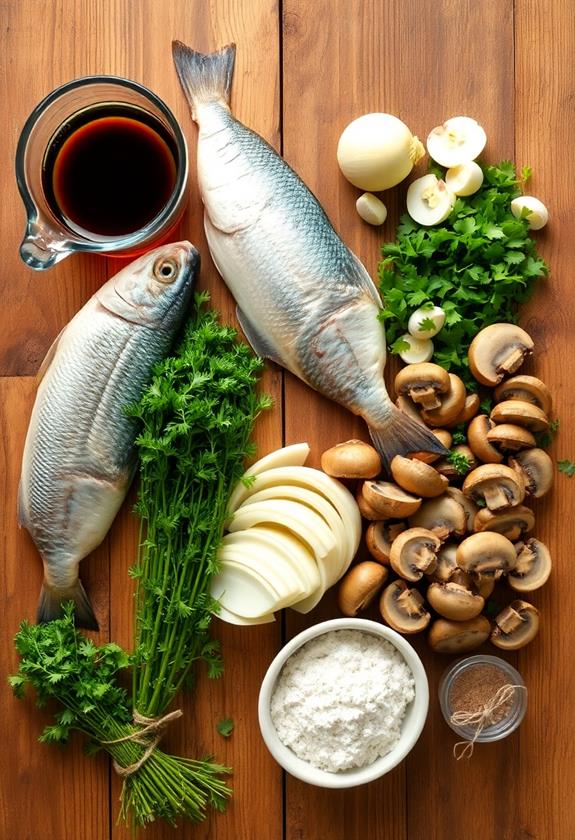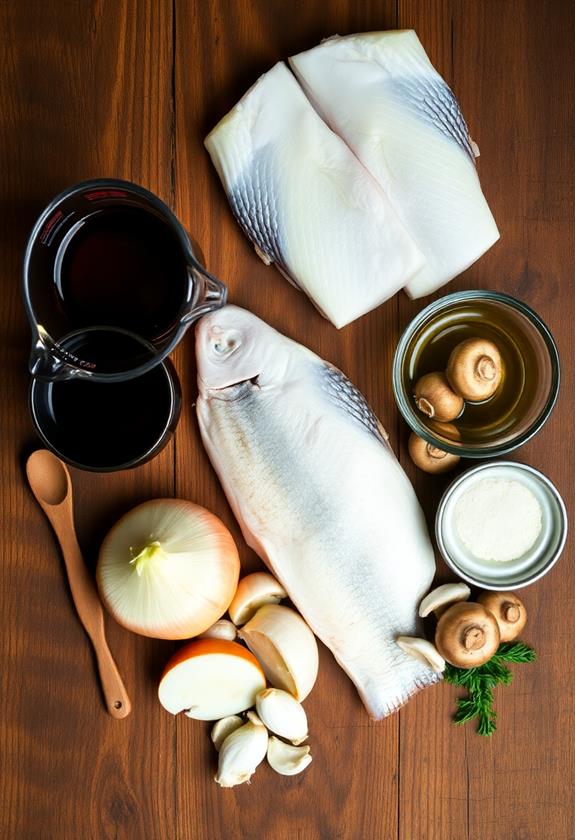Matelote is a delicious French fish stew that you can easily make at home! �� By using freshwater fish like eel or pike and cooking it in either red or white wine, you create a comforting dish. Begin by sautéing onions and mushrooms, then add your fish and simmer. Have you ever tried flambéing with cognac? It adds a fantastic touch! Serve it alongside crusty bread to soak up all those rich flavors. It's perfect for sharing with friends or family. Want to impress your guests with this classic dish? Keep exploring for tips and tricks to elevate your matelote.
History

Matelote, a delightful fish stew, has its origins in the 16th century, rooted in the Burgundy region of France. This classic dish showcases the best of French cuisine, traditionally featuring freshwater fish like eels, carp, and pike.
Curiously, the preparation of matelote can be enhanced by cooking methods such as smoking, which is a technique that brings out the flavors of the fish beautifully. 3 Best Ivation Charcoal Smokers can help achieve that perfect smoky flavor. Have you ever wondered how red wine plays a role in cooking? In matelote, it adds depth and flavor, making each bite a delightful experience.
Historical references to matelote can be found in the Dictionnaire de l'Académie française, where it's linked to sailors, or "matelots." Isn't it fascinating how food evolves over time? For instance, an 18th-century recipe by Hannah Glasse combined crayfish and pork, showing how matelote adapts to local tastes.
Curiously, the term matelote has sometimes been misused to describe non-fish dishes, like veal or poultry. However, the Larousse Gastronomique emphasizes its true essence as a seafood dish.
You might also encounter regional versions, such as matelote à la bourguignonne or matelote à la normande, each reflecting local flavors and traditions. These variations highlight how matelote holds a special place in the heart of French culinary history.
Recipe

Matelote is a sumptuous French fish stew that showcases the rich and diverse flavors of freshwater fish, complemented by a medley of vegetables and aromatic herbs. This delightful dish not only highlights the culinary traditions of France but also allows for creativity in the kitchen, making it a favorite among seafood lovers.
The interplay of wine, fish stock, and fragrant herbs creates a broth that's both comforting and elegant, perfect for a family dinner or a special occasion. To enhance your steaming experience while preparing Matelote, consider using a quality steamer basket like the Cuisinart CTG-00-SS for perfectly cooked vegetables that pair beautifully with the stew.
To prepare Matelote, select your choice of freshwater fish, such as eel, pike, or perch, which will form the heart of this stew. The key to a successful Matelote is the layering of flavors, starting with sautéed onions and mushrooms, followed by the addition of the fish and a bouquet garni.
The dish is further elevated by flambéing with cognac or brandy, which adds a depth of flavor that's simply irresistible. Serve your Matelote with sides that can soak up the delicious broth, such as boiled potatoes or crusty French bread.
Ingredients:
- 1 lb freshwater fish (eel, pike, or perch)
- 2 cups white or red wine
- 2 cups fish stock
- 1 large onion, sliced
- 8 oz mushrooms, sliced
- 2 cloves garlic, minced
- 2 tbsp butter
- 2 tbsp flour
- 1 bouquet garni (thyme, bay leaf, parsley)
- 1/4 cup cognac or brandy
- Salt and pepper to taste
- Fresh parsley and tarragon for garnish
- Sliced white bread for canapés
To cook the Matelote, begin by heating the butter in a large pot over medium heat. Add the sliced onions and mushrooms, sautéing until they're softened and fragrant. Stir in the minced garlic and cook for an additional minute.
Next, sprinkle the flour over the vegetables, mixing well to form a roux. Gradually pour in the wine and fish stock, stirring to combine, and bring the mixture to a simmer. Once bubbling, gently add the fish and bouquet garni, allowing it to cook for about 15-20 minutes until the fish is tender and cooked through.
Finally, flambé the stew with cognac or brandy, letting the flames subside before serving hot, garnished with fresh herbs and alongside canapés.
Extra Tips:
When making Matelote, feel free to experiment with different types of fish and vegetables based on seasonal availability. Always verify the fish is fresh for the best flavor and texture.
If you prefer a thicker stew, increase the amount of flour in the roux, or let the stew simmer longer to reduce the broth. Remember to taste and adjust the seasoning as needed, and consider serving with a nice chilled white wine to enhance the dining experience. Enjoy this traditional dish with good company for a memorable meal!
Final Thoughts

Enjoying a bowl of Matelote is truly a celebration of flavors and traditions. This hearty fish stew invites you to savor the rich tastes of freshwater fish, cooked perfectly in a delicious fish stock.
Have you ever thought about how aromatic ingredients like garlic cloves and parsley transform a dish? They not only add depth but also bring a fresh element to the stew. Additionally, using cookware like GreenPan Dutch Ovens can enhance your cooking experience, ensuring healthier meal preparation with minimal oil usage.
As you immerse yourself in your bowl, notice the delightful contrast between the tender fish and the sautéed mushrooms. These ingredients show how simple elements can create extraordinary flavors.
Whether you opt for red or white wine, each choice enhances the dish, making it a memorable experience.
Matelote isn't just a meal; it's about sharing moments with family and friends. Have you ever cooked a dish that brought everyone together?
With its regional variations, each version of Matelote tells a story of local traditions and sustainable ingredients.

